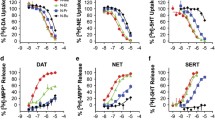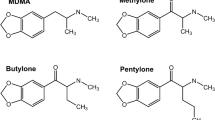Abstract
Rationale
New psychoactive substances (NPSs), including substituted cathinones and other stimulants, are synthesized, sold on the Internet, and ingested without knowledge of their pharmacological activity and/or toxicity. In vitro pharmacology plays a role in therapeutic drug development, drug-protein in silico interaction modeling, and drug scheduling.
Objectives
The goal of this research was to determine mechanisms of action that may indicate NPS abuse liability.
Methods
Affinities to displace the radioligand [125I]RTI-55 and potencies to inhibit [3H]neurotransmitter uptake for 22 cathinones, 6 benzofurans and another stimulant were characterized using human embryonic kidney cells stably expressing recombinant human transporters for dopamine, norepinephrine, or serotonin (hDAT, hNET, or hSERT, respectively). Selected compounds were tested for potencies and efficacies at inducing [3H]neurotransmitter release via the transporters. Computational modeling was conducted to explain plausible molecular interactions established by NPS and transporters.
Results
Most α-pyrrolidinophenones had high hDAT potencies and selectivities in uptake assays, with hDAT/hSERT uptake selectivity ratios of 83–360. Other substituted cathinones varied in their potencies and selectivities, with N-ethyl-hexedrone and N-ethyl-pentylone having highest hDAT potencies and N-propyl-pentedrone having highest hDAT selectivity. 4-Cl-ethcathinone and 3,4-methylenedioxy-N-propylcathinone had higher hSERT selectivity. Benzofurans generally had low hDAT selectivity, especially 1-(2,3-dihydrobenzofuran-5-yl)-N-methylpropan-2-amine, with 25-fold higher hSERT potency. Consistent with this selectivity, the benzofurans were releasers at hSERT. Modeling indicated key amino acids in the transporters’ binding pockets that influence drug affinities.
Conclusions
The α-pyrrolidinophenones, with high hDAT selectivity, have high abuse potential. Lower hDAT selectivity among benzofurans suggests similarity to methylenedioxymethamphetamine, entactogens with lower stimulant activity.





Similar content being viewed by others
References
Baumann MH, Ayestas MA Jr, Partilla JS et al (2012) The designer methcathinone analogs, mephedrone and methylone, are substrates for monoamine transporters in brain tissue. Neuropsychopharmacology 37:1192–1203
Baumann MH, Partilla JS, Lehner KR et al (2013) Powerful cocaine-like actions of 3,4-methylenedioxypyrovalerone (MDPV), a principal constituent of psychoactive ‘bath salts’ products. Neuropsychopharmacology 38:552–562
Blough BE, Landavazo A, Partilla JS et al (2014) Hybrid dopamine uptake blocker-serotonin releaser ligands: a new twist on transporter-focused therapeutics. ACS Med Chem Lett 5:623–627
Bonano JS, Banks ML, Kolanos R et al (2015) Quantitative structure-activity relationship analysis of the pharmacology of para-substituted methcathinone analogues. Br J Pharmacol 172:2433–2444
Cameron K, Kolanos R, Vekariya R, De Felice L, Glennon RA (2013) Mephedrone and methylenedioxypyrovalerone (MDPV), major constituents of “bath salts,” produce opposite effects at the human dopamine transporter. Psychopharmacology 227:493–499
Cheng Y, Prusoff WH (1973) Relationship between the inhibition constant (K1) and the concentration of inhibitor which causes 50 per cent inhibition (I50) of an enzymatic reaction. Biochem Pharmacol 22:3099–3108
Coleman JA, Green EM, Gouaux E (2016) X-ray structures and mechanism of the human serotonin transporter. Nature 532:334–339
Dal Cason TA, Young R, Glennon RA (1997) Cathinone: an investigation of several N-alkyl and methylenedioxy-substituted analogs. Pharmacol Biochem Behav 58:1109–1116
Dawson P, Opacka-Juffry J, Moffatt JD et al (2014) The effects of benzofury (5-APB) on the dopamine transporter and 5-HT2-dependent vasoconstriction in the rat. Prog Neuro-Psychopharmacol Biol Psychiatry 48:57–63
De Felice LJ, Glennon RA, Negus SS (2014) Synthetic cathinones: chemical phylogeny, physiology, and neuropharmacology. Life Sci 97:20–26
Drug Enforcement Administration (2011) Schedules of controlled substances: temporary placement of three synthetic cathinones in schedule I. Final Order Fed Regist 76:65371–65375
Drug Enforcement Administration (2017) Schedules of controlled substances: placement of 10 synthetic cathinones into schedule I. final rule. Fed Regist 82:12171–12177
Eshleman AJ, Carmolli M, Cumbay M et al (1999) Characteristics of drug interactions with recombinant biogenic amine transporters expressed in the same cell type. J Pharmacol Exp Ther 289:877–885
Eshleman AJ, Wolfrum KM, Hatfield MG et al (2013) Substituted methcathinones differ in transporter and receptor interactions. Biochem Pharmacol 85:1803–1815
Eshleman AJ, Wolfrum KM, Reed JF et al (2017) Structure-activity relationships of substituted cathinones, with transporter binding, uptake, and release. J Pharmacol Exp Ther 360:33–47
Friesner RA, Banks JL, Murphy RB et al (2004) Glide: a new approach for rapid, accurate docking and scoring. 1. Method and assessment of docking accuracy. J Med Chem 47:1739–1749
Friesner RA, Murphy RB, Repasky MP et al (2006) Extra precision glide: docking and scoring incorporating a model of hydrophobic enclosure for protein-ligand complexes. J Med Chem 49:6177–6196
Fuwa T, Suzuki J, Tanaka T et al (2016) Novel psychoactive benzofurans strongly increase extracellular serotonin level in mouse corpus striatum. J Toxicol Sci 41:329–337
Gatch MB, Rutledge MA, Forster MJ (2015) Discriminative and locomotor effects of five synthetic cathinones in rats and mice. Psychopharmacology 232:1197–1205
Gatch MB, Forster MJ, Janowsky A, Eshleman AJ (2011) Abuse liability profile of three substituted tryptamines. J Pharmacol Exp Ther 338:280–289
Glennon RA, Dukat M (2017) Structure-activity relationships of synthetic cathinones. Curr Top Behav Neurosci 32:19–47
Hadlock GC, Webb KM, McFadden LM et al (2011) 4-Methylmethcathinone (mephedrone): neuropharmacological effects of a designer stimulant of abuse. J Pharmacol Exp Ther 339:530–536
Halgren TA, Murphy RB, Friesner RA et al (2004) Glide: a new approach for rapid, accurate docking and scoring. 2. Enrichment factors in database screening. J Med Chem 47:1750–1759
Hofer KE, Faber K, Muller DM et al (2017) Acute toxicity associated with the recreational use of the novel psychoactive benzofuran N-methyl-5-(2 aminopropyl)benzofuran. Ann Emerg Med 69:79–82
Iversen L, Gibbons S, Treble R et al (2013) Neurochemical profiles of some novel psychoactive substances. Eur J Pharmacol 700:147–151
King LA, Corkery JM (2018) An index of fatal toxicity for new psychoactive substances. J Psychopharmacol 32:793–801
Kolanos R, Sakloth F, Jain AD et al (2015) Structural modification of the designer stimulant alpha-pyrrolidinovalerophenone (alpha-PVP) influences potency at dopamine transporters. ACS Chem Neurosci 6:1726–1731
Krotulski AJ, Mohr LA, Papsun DM, Logan BK (2018) Dibutylone (bk-DMBDB): intoxications, quantitative confirmations and metabolism in authentic biological specimens. J Anal Toxicol 42:437–445
Kuhar MJ, Ritz MC, Boja JW (1991) The dopamine hypothesis of the reinforcing properties of cocaine. Trends Neurosci 14:299–302
de la Torre R, Farre M, Roset PN et al (2004) Human pharmacology of MDMA: pharmacokinetics, metabolism, and disposition. Ther Drug Monit 26:137–144
Ledberg A (2015) The interest in eight new psychoactive substances before and after scheduling. Drug Alcohol Depend 152:73–78
Lopez-Arnau R, Martinez-Clemente J, Pubill D et al (2012) Comparative neuropharmacology of three psychostimulant cathinone derivatives: butylone, mephedrone and methylone. Br J Pharmacol 167:407–420
Luethi D, Kolaczynska KE, Docci L et al (2018) Pharmacological profile of mephedrone analogs and related new psychoactive substances. Neuropharmacology 134:4–12
Marusich JA, Antonazzo KR, Wiley JL et al (2014) Pharmacology of novel synthetic stimulants structurally related to the “bath salts” constituent 3,4-methylenedioxypyrovalerone (MDPV). Neuropharmacology 87:206–213
McLaughlin G, Morris N, Kavanagh PV et al (2017) Synthesis, characterization and monoamine transporter activity of the new psychoactive substance mexedrone and its N-methoxy positional isomer, N-methoxymephedrone. Drug Test Anal 9:358–368
Meltzer PC, Butler D, Deschamps JR, Madras BK (2006) 1-(4-Methylphenyl)-2-pyrrolidin-1-yl-pentan-1-one (pyrovalerone) analogues: a promising class of monoamine uptake inhibitors. J Med Chem 49:1420–1432
Monte AP, Marona-Lewicka D, Cozzi NV, Nichols DE (1993) Synthesis and pharmacological examination of benzofuran, indan, and tetralin analogues of 3,4-(methylenedioxy)amphetamine. J Med Chem 36:3700–3706
Qing X, Lee XY, De Raeymaecker J, Tame J et al (2014) Pharmacophore modeling: advances, limitations, and current utility in drug discovery. J Receptor Ligand Channel Res 7:81–92
Rickli A, Hoener MC, Liechti ME (2015a) Monoamine transporter and receptor interaction profiles of novel psychoactive substances: para-halogenated amphetamines and pyrovalerone cathinones. Eur Neuropsychopharmacol 25:365–376
Rickli A, Kopf S, Hoener MC, Liechti ME (2015b) Pharmacological profile of novel psychoactive benzofurans. Br J Pharmacol 172:3412–3425
Ritz MC, Lamb RJ, Goldberg SR, Kuhar MJ (1987) Cocaine receptors on dopamine transporters are related to self-administration of cocaine. Science 237:1219–1223
Roberts L, Ford L, Patel N et al (2017) 11 analytically confirmed cases of mexedrone use among polydrug users. Clin Toxicol (Phila) 55:181–186
Saha K, Partilla JS, Lehner KR et al (2015) ‘Second-generation’ mephedrone analogs, 4-MEC and 4-MePPP, differentially affect monoamine transporter function. Neuropsychopharmacology 40:1321–1331
Sakloth F, Kolanos R, Mosier PD et al (2015) Steric parameters, molecular modeling and hydropathic interaction analysis of the pharmacology of para-substituted methcathinone analogues. Br J Pharmacol 172:2210–2218
Sali A, Blundell TL (1993) Comparative protein modelling by satisfaction of spatial restraints. J Mol Biol 234:779–815
Sandtner W, Stockner T, Hasenhuetl PS et al (2016) Binding mode selection determines the action of ecstasy homologs at monoamine transporters. Mol Pharmacol 89:165–175
Schindler CW, Thorndike EB, Goldberg SR et al (2016) Reinforcing and neurochemical effects of the “bath salts” constituents 3,4-methylenedioxypyrovalerone (MDPV) and 3,4-methylenedioxy-N-methylcathinone (methylone) in male rats. Psychopharmacology 233:1981–1990
Shen MY, Sali A (2006) Statistical potential for assessment and prediction of protein structures. Protein Sci 15:2507–2524
Sherman W, Day T, Jacobson MP et al (2006) Novel procedure for modeling ligand/receptor induced fit effects. J Med Chem 49:534–553
Shimshoni JA, Winkler I, Golan E, Nutt D (2017) Neurochemical binding profiles of novel indole and benzofuran MDMA analogues. Naunyn Schmiedeberg’s Arch Pharmacol 390:15–24
Simmler LD, Liechti ME (2017) Interactions of cathinone NPS with human transporters and receptors in transfected cells. Curr Top Behav Neurosci 32:49–72
Simmler LD, Liechti ME (2018) Pharmacology of MDMA- and amphetamine-like new psychoactive substances. In: Handbook of experimental pharmacology. Springer, Berlin. https://doi.org/10.1007/164_2018_113
Simmler LD, Rickli A, Hoener MC, Liechti ME (2014) Monoamine transporter and receptor interaction profiles of a new series of designer cathinones. Neuropharmacology 79:152–160
Staeheli SN, Boxler MI, Oestreich A et al (2017) Postmortem distribution and redistribution of MDAI and 2-MAPB in blood and alternative matrices. Forensic Sci Int 279:83–87
Tettey JNA, Crean C, Ifeagwu SC, Raithelhuber M (2018) Emergence, diversity, and control of new psychoactive substances: a global perspective. In: Handbook of experimental pharmacology. Springer, Berlin. https://doi.org/10.1007/164_2018_127
Tyrkko E, Andersson M, Kronstrand R (2016) The toxicology of new psychoactive substances: synthetic cathinones and phenylethylamines. Ther Drug Monit 38:190–216
Uchiyama N, Matsuda S, Kawamura M et al (2014) Characterization of four new designer drugs, 5-chloro-NNEI, NNEI indazole analog, alpha-PHPP and alpha-POP, with 11 newly distributed designer drugs in illegal products. Forensic Sci Int 243:1–13
Webb B, Sali A (2017) Protein structure modeling with MODELLER. Methods Mol Biol 1654:39–54
Wee S, Woolverton WL (2006) Self-administration of mixtures of fenfluramine and amphetamine by rhesus monkeys. Pharmacol Biochem Behav 84:337–343
Wee S, Anderson KG, Baumann MH et al (2005) Relationship between the serotonergic activity and reinforcing effects of a series of amphetamine analogs. J Pharmacol Exp Ther 313:848–854
Welter-Luedeke J, Maurer HH (2016) New psychoactive substances: chemistry, pharmacology, metabolism, and detectability of amphetamine derivatives with modified ring systems. Ther Drug Monit 38:4–11
Yu H, Rothman RB, Dersch CM et al (2000) Uptake and release effects of diethylpropion and its metabolites with biogenic amine transporters. Bioorg Med Chem 8:2689–2692
Acknowledgments
We thank the OHSU Medicinal Chemistry Core for the drug-transporter modeling and analysis.
Role of funding source
DEA project officers contributed to the study design and reviewed the manuscript. They had no further role in the collection, analysis, and interpretation of data; in the writing of the report; or in the decision to submit the paper for publication.
Funding
Funding for this study was provided by the Department of Justice Drug Enforcement Administration (D-15-OD-0002), Veterans Affairs Merit Review (I01BX002758) and Career Scientist (14S-RCS-006) programs, the Methamphetamine Abuse Research Center (P50 DA018165), and National Institutes of Health/National Institute on Drug Abuse (ADA12013). The contents do not represent the views of the United States Department of Veterans Affairs or the United States Government.
Author information
Authors and Affiliations
Contributions
Participated in the research design: Eshleman, Janowsky, Nagarajan, and Nilsen
Conducted the experiments: Eshleman, Wolfrum, Reed, and Swanson
Performed the data analysis: Eshleman, Wolfrum, Reed, Swanson, and Nagarajan
Wrote or contributed to the writing of the manuscript: Eshleman, Janowsky, Nagarajan, and Nilsen
Corresponding author
Ethics declarations
Conflict of interest
The authors declare that they have no conflicts of interest.
Additional information
This article belongs to a Special Issue on Bath Salts
Rights and permissions
About this article
Cite this article
Eshleman, A.J., Nagarajan, S., Wolfrum, K.M. et al. Structure-activity relationships of bath salt components: substituted cathinones and benzofurans at biogenic amine transporters. Psychopharmacology 236, 939–952 (2019). https://doi.org/10.1007/s00213-018-5059-5
Received:
Accepted:
Published:
Issue Date:
DOI: https://doi.org/10.1007/s00213-018-5059-5




